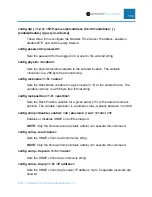
PVIQ™ CONNECTIVITY SYSTEM USER MANUAL V 1.0
148
the step 3 of the
Executing the Standalone TFTP Server
section above.
i. Example of the above standalone TFTP server: 192.168.0.250
b. If you are using a TFTP server on your network us the IP address that
your network administrator provided for the network TFTP server.
6. If you want to delay the start time of the Firmware Update, select the number of
minutes to delay before Firmware update starts in the
Delay
pulldown field.
7. There may be multiple reasons why firmware update may not happen on the first
few tries (i.e. integrity of the network, congestion on the network, etc.), so the
option to perform retries is necessary to increase the chances of firmware update
success. If you want the system to retry firmware update, select the number of
retries in the
Max Retries
pulldown field.
Placing a delay between the retries may help improve the chances of success. If
you want the system to delay between retrying firmware update, select the
number of minutes to delay between firmware update retries in the
Retry
Interval
pulldown field.
8. The PViQ™ Connectivity System goes into Maintenance mode when firmware
update is initiated. When the System is in Maintenance Mode it will beep an
audio alert every 15 seconds. If you want to disable the audio alert during
firmware update, click on the check box to cause a check mark in the
Disable
Beep
field.
9. Start the PViQ™ Connectivity System firmware update process by clicking on the
Start TFTP Download
button.
a.
Update Status
and
Error Status
will provide status of the firmware
update while it progresses.
b. The firmware upgrade procedure verifies the image by validating the
signature of the images. If the signature does not match, the firmware
upgrade procedure will ignore the image and remain on the current
version.
10. When the firmware update is finished, the system will reboot automatically.






























